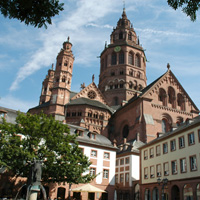Public Transportation in Berlin
Summary: Learning how to get around using public transportation in Berlin is an important step in adjusting to life in Berlin. In this article, we cover the local public transportation options.
Berlin, the vibrant capital of Germany, is a hotspot for digital nomads who are drawn to its rich history, dynamic culture, and innovative tech scene. Navigating this sprawling city is made easy thanks to its comprehensive and efficient public transportation system. Whether you're hopping between co-working spaces, exploring neighborhoods, or meeting up with fellow nomads, Berlin's transport options are designed to get you where you need to go with minimal fuss.
U-Bahn and S-Bahn
The backbone of Berlin's public transportation is the U-Bahn (underground subway) and S-Bahn (suburban train) networks. With numerous lines crisscrossing the city, they provide a fast and reliable way to travel. The U-Bahn operates 10 lines (U1 to U9 and U55), while the S-Bahn has 15 lines (S1 to S9, S25, S26, S41, S42, S45, S46, and S47) that connect the city center with the outer districts and surrounding areas. Tickets can be purchased at stations and must be validated before boarding. For routes and schedules, visit the official BVG website at www.bvg.de/en.
Trams and Buses
Complementing the U-Bahn and S-Bahn, Berlin's tram and bus services offer extensive coverage, especially in areas not serviced by the rail networks. Trams are particularly prevalent in the eastern parts of the city, with 22 tram lines (including 9 night lines). Buses cover the entire city with over 300 day and night bus routes, ensuring that even the most remote locations are accessible. Timetables and route information can be found on the BVG website.
Regional Trains
For longer distances or trips to the outskirts of Berlin, regional trains (Regionalbahn or Regional-Express) are an excellent choice. They connect Berlin with the surrounding Brandenburg region and other major cities in Germany. These trains are operated by Deutsche Bahn (DB), and you can find schedules and book tickets on their website at www.bahn.de/en.
Ferries
Not to be overlooked, Berlin also has a number of ferry routes that can be a scenic and leisurely way to travel, especially during the warmer months. Operated by BVG, these ferries cross several lakes and rivers, offering a unique perspective of the city from the water. Information on ferry services can be found on the BVG website.
Bikes
Berlin is an incredibly bike-friendly city, with an extensive network of bike lanes and plenty of bike rental options. Digital nomads can take advantage of services like Nextbike or Deutsche Bahn's Call a Bike to rent bikes on a short-term basis. For those planning to stay longer, purchasing a second-hand bike might be a cost-effective option. Cycling is not only a great way to stay fit but also allows for flexible and spontaneous exploration of the city.
Helpful Apps
To streamline your travel experience, there are several apps that can be invaluable for getting around Berlin. The BVG Fahrinfo app provides real-time information on all public transport options, allowing you to plan your journey with ease. Other apps like Google Maps and Citymapper also offer comprehensive transit directions and are useful for comparing different routes and modes of transportation.
Safety
Public transportation in Berlin is generally safe, with a low crime rate compared to other major cities. However, it's always wise to stay vigilant, especially at night or in less crowded areas. Keep an eye on your belongings, be aware of your surroundings, and don't hesitate to contact the authorities if you feel unsafe. The emergency number in Germany is 112, and there are usually staff members at larger stations who can assist in case of any issues.
With its diverse range of public transportation options, Berlin is a city that's easy to navigate for digital nomads. Whether you're in town for a few weeks or planning an extended stay, the efficient and well-connected system will ensure that your focus remains on your work and the rich experiences the city has to offer, rather than on how to get from point A to point B.
About the Author
 Betsy Burlingame is one of the founders of Digital Nomad Exchange and the Founder and President of Expat Exchange. She launched Expat Exchange in 1997 as her Master's thesis project at NYU. Prior to Expat Exchange and Digital Nomad Exchange, Betsy worked at AT&T in International
and Mass Market Marketing. She graduated from Ohio Wesleyan University
with a BA in International Business and German.
Betsy Burlingame is one of the founders of Digital Nomad Exchange and the Founder and President of Expat Exchange. She launched Expat Exchange in 1997 as her Master's thesis project at NYU. Prior to Expat Exchange and Digital Nomad Exchange, Betsy worked at AT&T in International
and Mass Market Marketing. She graduated from Ohio Wesleyan University
with a BA in International Business and German.
Some of Betsy's articles include 12 Best Places to Live in Portugal, 7 Best Places to Live in Panama and 12 Things to Know Before Moving to the Dominican Republic. Betsy loves to travel and spend time with her family. Connect with Betsy on LinkedIn.

SJB Global is a top-rated financial advisory firm specializing in expat financial advice worldwide, offering retirement planning & tax-efficient solutions with a regressive fee model.
Learn More
 SJB Global
SJB GlobalSJB Global is a top-rated financial advisory firm specializing in expat financial advice worldwide, offering retirement planning & tax-efficient solutions with a regressive fee model.
Learn More
![]() Germany Forum
Germany Forum
Talk with other digital nomads and expats in Germany on our Germany forum - meet people, get advice and help others.
![]() Contribute
Contribute
Help others in Germany by answering questions about the challenges and adventures of living in Germany.
Digital Nomads in Germany offer advice about healthcare, hospital visits, emergency rooms visits, finding a doctor and buying health insurance in Germany.

 Berlin, Germany
Berlin, Germany



